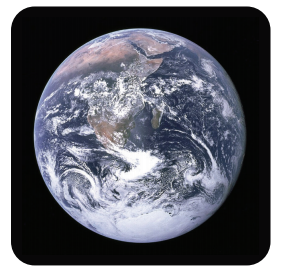- Practical exercise 1 Making models of the objects of the Solar System
- Practical exercise 2 Model the motion of Earth around the Sun
- Practical exercise 3 What are the distances of planets from the Sun?
- Practical exercise 4 What are the planets’ sizes?
- Practical exercise 5 When observing from Earth, why can we see the tilting of Saturn’s rings?
- Practical exercise 6 Model the motion of Uranus around the Sun and describe how seasons change for var-ious hypothetical positions of an observer on the „surface“ of Uranus.
Practical exercise 2: Model the motion of Earth around the Sun
Aids:
• the models of the Sun and Earth, or also the model of Moon (see section a), a pin with a coloured round head, strong source of light, calculator, charts
Instructions:
1. Place the models of the Sun and Earth on the table. Put the pin with the coloured head into the model of the Earth in the spot where the Slovak Republic is. The pin will mark the location of the observer.
2. Place the strong source of light in front of the Sun’s model in such a way that it lightens the Earth. By rotating the Earth around its axis (pay attention to the correct direction of the rotation: the country rotates from west to east) demonstrate day and night alternation in the location of the observer. At the same time watch how day and night alter in other places of Earth.
3. Demonstrate the motion of Earth around the Sun on its circular trajectory. Put the Sun in the middle of the desk. Put the Earth in the distance of about 15 cm from the Sun. Demonstrate the motion of Earth around the Sun on its orbital trajectory (neglect Earth’s rotation). Pay attention to the correct position of the Earth’ axis while orbiting the Sun (the position of Earth’s axis does not change in relation to distant stars).
4. Demonstrate how the situation changes if we do not neglect the trajectory ecliptic of Earth around the Sun. Place the Sun in the middle of the desk again. With the help of charts calculate the minimal and maximal distance of Earth from the Sun and mark it on the desk with a chalk. Place the Earth into minimal distance from the Sun. Pay attention to the correct position of Earth’s axis (Earth is in the minimal distance from the Sun in winter, actually early January). Demonstrate the motion of Earth around the Sun again.
5. Place the Sun and Earth on the desk again. Place there also the Moon. Assume that the Moon rotates exactly on the plane where Earth orbits the Sun. How many times does Moon orbit Earth in one year? With a classmate’s help now demonstrate the motion of Earth around the Sun while maintaining the correct ratio of rotations’ periods of Moon around Earth.
6. Calculate the sizes of Earth’s and Sun’s models so that they are in the same ratio as their distance. The models are placed on the desk 15 cm from each other.
• What spherical object would have its size calculated this way and could be a correct model in terms of size instead of a table tennis ball? What object would represent Earth?
• Assume that the Sun is modeled by a table tennis ball with the diameter 4 cm. In what distance should the model of Earth be located? An object of what size would represent it in the correct ratio?
7. Move the model of Earth around the Sun and at the same time demonstrate the rotation of Earth about its axis.
• Define all latitudes in the which the Sun is observed in the sky at least once a year towards the south, it means as it is in our latitude.

(source: https://www.nasa.gov/multimedia/imagegallery/image_feature_329.html)


